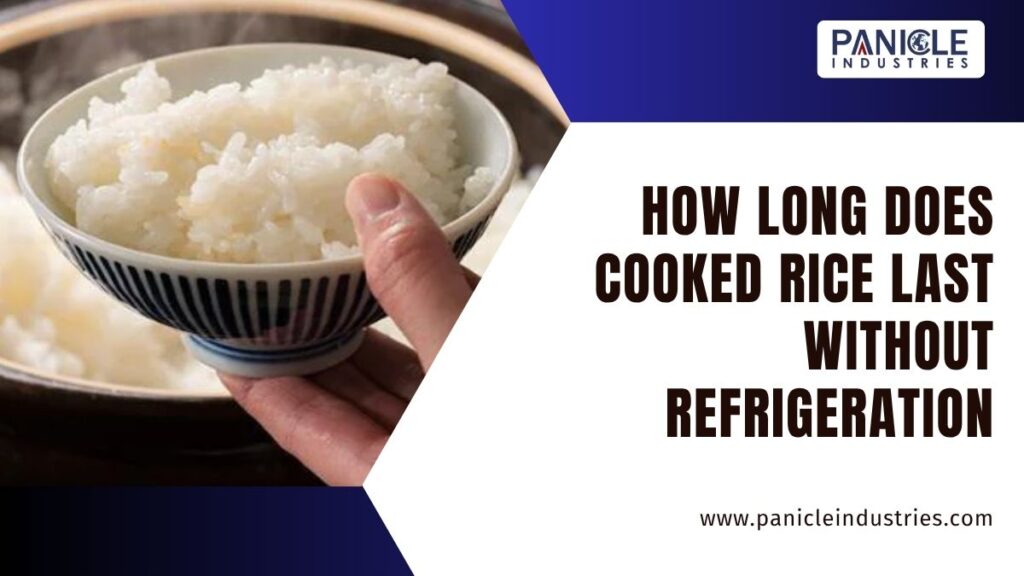Cooked rice is a common food in many homes. It’s quick to make, tasty, and goes well with many dishes. But one important question that many people ask is: how long does cooked rice last without refrigeration? This is something we all need to know, especially if we often cook extra rice or forget to put it in the fridge. Leaving cooked rice out at room temperature can be risky. It may look fine on the outside, but inside, bacteria can grow fast.
In this blog, we’ll talk about how long cooked rice stays safe to eat without refrigeration, signs that it has gone bad, and how to store it properly to avoid food poisoning.
Why Cooked Rice Can Go Bad Quickly
Cooked rice may seem harmless, but it can spoil faster than you think. This is because rice contains a type of bacteria called Bacillus cereus. This bacteria can survive the cooking process and grow when rice is left at room temperature.
Once the rice cools down after cooking, it enters what food safety experts call the danger zone (between 40°F to 140°F or 4°C to 60°C). In this temperature range, bacteria grow very fast. Even if the rice looks and smells okay, it may already be unsafe to eat.
That’s why it’s important to know the right way to store rice and how long it can stay out without getting spoiled.
Also read: Can You Freeze Cooked Rice
So, How Long Does Cooked Rice Last Without Refrigeration?
If you leave cooked rice out at room temperature, it usually stays safe for only 1 to 2 hours. After that, bacteria can grow to dangerous levels. In very cool climates or air-conditioned rooms, it might last a little longer—maybe up to 3 hours—but it’s still risky.
Here’s a simple rule:
- Eat cooked rice within 2 hours if it’s not in the fridge.
- After 2 hours, throw it away to be safe.
If the room is very hot (above 90°F or 32°C), like during summer, rice can go bad even faster—within just 1 hour.
What Happens If You Eat Spoiled Cooked Rice?
Eating rice that’s been sitting out too long can lead to food poisoning. The main danger comes from the Bacillus cereus bacteria we talked about earlier. This bacteria produces toxins that heat cannot kill. So, even reheating spoiled rice won’t make it safe again.
Common symptoms of food poisoning from bad rice include:
- Stomach pain
- Nausea
- Vomiting
- Diarrhea
These symptoms usually start within a few hours after eating the rice. While it may not always be serious, it can be very uncomfortable and dangerous for children, older adults, or people with weak immune systems.
Signs That Cooked Rice Has Gone Bad
Sometimes, it’s hard to tell if rice is spoiled just by looking at it. But here are some signs that your rice is no longer safe to eat:
- Unpleasant Smell: If your rice smells sour, musty, or off in any way, throw it out.
- Change in Texture: Sticky rice is normal, but if it becomes overly slimy or very hard, it’s not safe.
- Discoloration: If you notice any unusual spots, mold, or color changes, don’t eat it.
- Time Left Out: Even if it looks fine, rice that has been out for more than 2 hours should be thrown away.
It’s always better to be safe than sorry when it comes to food.
How to Store Cooked Rice Properly
To keep cooked rice fresh and safe, you need to cool it quickly and store it the right way.
Follow these steps:
- Cool it fast: After cooking, don’t leave rice sitting in the pot for hours. Spread it out on a plate or tray to cool quickly. You can also place the pot in a bowl of cold water to bring down the temperature faster.
- Use airtight containers: Once the rice is cool, put it in a clean, airtight container. This keeps out moisture and bacteria.
- Refrigerate: Store the rice in the refrigerator within 1 to 2 hours of cooking. It will stay safe in the fridge for about 3 to 4 days.
- Freeze if needed: If you don’t plan to eat the rice soon, freeze it. Frozen rice can last for up to 1 month and still taste good when reheated.
How to Reheat Cooked Rice Safely
Reheating rice the right way is important. You should heat it until it is steaming hot all the way through. This kills most bacteria, though not all toxins made by Bacillus cereus.
You can reheat rice in a microwave, on the stove, or in the oven:
- Microwave: Sprinkle a few drops of water on the rice, cover it, and heat for 1–2 minutes.
- Stove: Add a bit of water and stir while heating in a pan.
- Oven: Place rice in a covered dish with some water and heat at 300°F (150°C) for 15–20 minutes.
Never reheat rice more than once. Only take out the portion you plan to eat.
Can You Keep Cooked Rice Overnight Without Refrigeration?
Many people wonder if they can leave cooked rice out overnight and still eat it the next day. The simple answer is no. Cooked rice that has been left out for more than 4 hours (especially overnight) is not safe to eat, even if it smells and looks fine.
Even if you reheat it, the bacteria may have already made toxins that are harmful and cannot be destroyed by heat. To avoid this, always store leftover rice in the fridge.
Tips to Avoid Wasting Rice
If you often cook more rice than you need, here are some tips to avoid waste:
- Cook only what you need: Use a measuring cup to get the right amount.
- Cool and store quickly: As soon as you’re done eating, cool down the extra rice and refrigerate it.
- Use leftovers in new dishes: Use stored rice to make fried rice, rice pudding, or rice salads the next day.
- Label containers: If you freeze rice, write the date on the container so you know when to use it.
Conclusion
Cooked rice is tasty, healthy, and easy to make—but it also spoils fast if not handled properly. As we’ve learned, how long does cooked rice last without refrigeration depends on time and temperature. In general, rice should not be left out for more than 2 hours. If you forget and leave it overnight, it’s safer to throw it away. Eating spoiled rice can make you sick, so always store it the right way. Put it in the fridge quickly, use airtight containers, and reheat it properly. By following these simple tips, you can keep your rice safe to eat and avoid food poisoning for you and your family.


